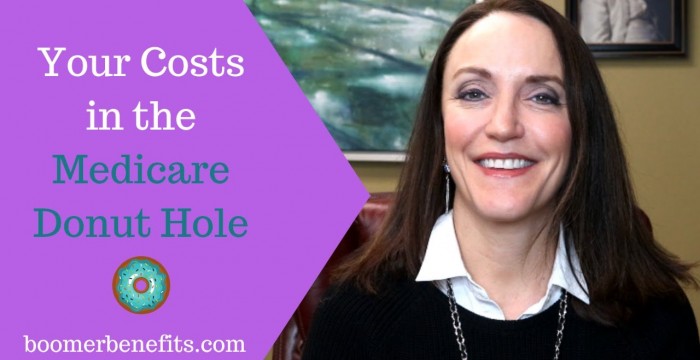The Medicare Part D donut hole is just a term coined by ordinary people for the stage of Medicare Part D that is officially called the coverage gap. The reason they call it the Medicare donut hole is because it’s a hole in the middle of your drug coverage during a calendar year. There are NO Medicare Part D plans without the donut hole, so you will want to understand your costs in the Medicare Donut Hole.
medicare donut hole
The Medicare Part D donut hole is a stage in every drug plan where your coinsurance for your medications is higher.
What is the Medicare Donut Hole?
The Medicare Donut hole is a gap inside of your Part D plan. It is a period of the year when your medication costs can be higher.
Congress designed Part D so that it would provide coverage for the majority of your prescription drugs. However, a small percentage of people have medication costs that go well beyond average spending. Those people then share in a greater portion of the costs for their medications when they enter the coverage gap.
Medicare designed the gap to encourage beneficiaries, whenever possible, to seek generics or drug alternatives that are lower in cost. This helps Medicare to keep the total costs for the Part D program as low as possible.
How the Coverage Gap Works
The coverage gap starts after the combined spending by you and your insurance company reaches a certain annual limit. Medicare sets this limit each year. In 2019, the gap begins when your drug cost reaches $3,820. Before you reach the gap, you will normally pay copays for each medication. After you reach the gap, you will pay a percentage of the cost of each medication. If the medication has a high retail price, this may mean your costs for the medication will increase while you are in the gap.
Donut Hole Expenses
In 2019, you pay 25% of the cost of your brand-name medications and 37% of generics once you reach the Medicare donut hole. So if a certain medication costs $100, and you were paying a Tier 3 copay of $30 before you reached the gap, the same medication will now cost you $25 when you are in the gap.
You will also have a discount on generic medications. Some plans will continue to offer you copays in the gap for generic medications as an added value for that plan.
Medicare continues to tally the spending between you and your insurance company while you are in the gap. If your total out of pocket drug expenses reach $5100 in 2019, then you exit the gap. You reach the fourth stage of Medicare Part D, called catastrophic coverage. At this stage, you will pay no more than 5% of the cost of your medications for the rest of the year. The insurance company picks up the rest.
Some medications fall outside of Part D altogether, and therefore do not get tallied toward the Medicare donut hole. See our list of medications not covered by Part D for more information on that.
While the coverage gap can be painful, it’s important to remember that, just a few years ago, there was no prescription drug program for Medicare beneficiaries. Medicare Part D has greatly helped to reduce drug spending for millions of Medicare recipients.
Most Part D carriers negotiate discounted drug rates with pharmaceutical manufacturers, too. You get the benefit of these discounts just for being a plan member.
Boomer Benefits provides free claims support for life for all of our Medigap and Medicare Advantage policyholders so that you are never alone in dealing with Medicare.
Get our best tips for saving money with Part D:
We are licensed in 47 states and we are a top-producing, award winning agency with over 2000 5-star reviews from Medicare beneficiaries just like you.
New to Medicare? Attend our FREE Medicare 101 Webinar:
Get our FREE 6-Day Medicare Video Email course with bonus Medicare cost worksheet:
To learn about Medicare and Employer Coverage:
Join our 100,000+ Fans on Facebook:
~~~~~~~~~~~~~~~~~~~~~~~~~~~~~~~~~~~~~~~~~
Subscribe for NEW YouTube Videos! Be sure to hit the bell to be notified whenever we publish them:
~~~~~~~~~~~~~~~~~~~~~~~~~~~~~~~~~~~~~~~~~







Do you have a question about the Medicare Part D Donut Hole? Let us know and we’ll answer.
Great information!!
Who determines what tier a specific drug is in?
The insurance carrier decides which tier to place a drug in. However, they cannot place a medication into the Specialty tier unless the drug has a retail price tag of over $600.
If I only take one med, would I go into the donut hole?
It would depend on the cost of the medication. So if the total cost of the drug is $400/month, then before 12 months is up, you are going to pass the $3820 threshhold and fall into the donut hole. If the drug is $300 or less, then you wouldn’t fall into the gap unless you filled other medications later in the year that made you reach the $3820.
+Boomer Benefits Oh okay. Thank you for such a quick reply.
Danielle Roberts is the BEST at explaining the details of Medicare. I highly recommend her and her team. Great video Danielle.
Aw, thanks Michael!
Good explanation. Thanks Danielle,
The costs of some anti-cancer drugs are astronomical, even for their generic counterparts. At the present time, my medication is covered under Medicare Parts B and F. It is a generic drug but if I didn’t have Medicare Part F, I would have a copay of $830 every three weeks! I dread the thought of being switched to an anti-cancer drug covered under Part D due to the costs I would be responsible for in the Donut Hole.
I will be enrolled for Medicare Parts A and B by Social Security Disability in Aug 2019. I will be 63 years old in May 2019. Will I have to pay the Part D late enrollment penalty if I wait until I turn 65 to buy a Part D policy?
No. At age 65 you get a “do over” and then receive retirement benefits rather than disability benefits. A better strategy is to buy the lowest premium part D when first eligible, not knowing what may be prescribed in the future, then checking Plan Finder each year at Annual Enrollment.
Thanks Lynda, that is what I’ll do.
Lynda is exactly right. You only start gaining a late penalty for Part D if you don’t enroll after turning 65. If you have no other form of drug coverage currently, you should find a Part D plan that works for you now.
I currently have my medigap coverage with another agency and would like to switch to Boomer Benefits for 2020 using the same plan. Is that possible?
Hi Pauline – to become our client, our agents would have to write you a new policy. In most cases, the insurance company will perform medical underwriting to see if you qualify. In some states, there are rules that allow you to change Medicare supplement plans without underwriting.
You can always reach out to our team to see how we could help lower your premiums and then of course, all of our clients have direct access to the Client Service Team.
https://boomerbenefits.com/faq/can-i-change-my-medigap-policy-during-the-annual-enrollment/
Is the $5100 out-of-pocket maximum to exit the gap include the total retail cost of the drugs or just my personal out-of pocket expense?
Hi Frank – the $5,100 will include the total retail cost of the drug not just what you pay.
Is there a part D out of pocket max? I take one cancer drug that costs $15,000 per month.
Yes on Part D in 2019, catastrophic coverage kicks in at $5100. If you spend that in a calendar year, then afterward the insurance carrier must pay 95% of the cost of your drugs for the rest of the year.
Boomer Benefits THANK YOU. I was panicking over the drug benefit
You are welcome! Just be sure to do the Medigap plans and NOT the Medicare Advantage plans. On many Advantage plans the chemo will cost you 20%. You want Medigap so that between Medicare and your plan, it’s covered 100%. I recommend Medigap for anyone that has had cancer.